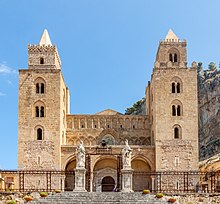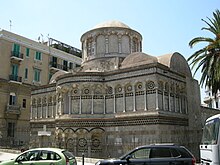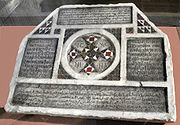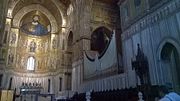Norman-Arabic-Byzantine art
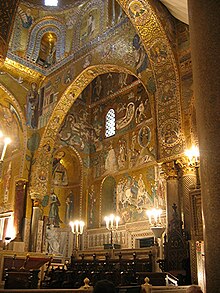
As Norman-Arab-Byzantine art one for is Sicily Christian-Islamic mixed culture typical indicated that after the Norman emerged conquest of Palermo 1060-1088 and in the 13th century by the normannisch- Staufer was replaced Art. It is also known as the Norman-Sicilian style or Sicilian Romanesque . However, their effects can be seen as far as Salerno on the Italian mainland or into the subsequent Gothic period .
Synthesis and symbiosis
This synthesis came about because the Normans did not colonize Sicily, but only provided the ruling class there. The population and thus also the craftsmen and artists who carried out the Norman buildings were still a mixture of the Greco-Byzantine population and the Muslim Arabs who had conquered and populated the island in the 9th century. There was also a temporary symbiosis at court: the Norman kings surrounded themselves with both Greek and Arab advisers, maintained an oriental harem, chose government mottos from the Koran and had Islamic names of honor stamped on their coins.
architecture
The architectural style of this epoch in Sicily and neighboring parts of the Italian mainland differs from the contemporary Romanesque style of the rest of Italy and the rest of Latin Europe, as occidental, Islamic and Byzantine influences merge to form a harmonious unit. Since the Norman King Roger II, as the "defender of Christianity" on the one hand, but also as the "King of Ifrīqiya " on the other hand, continued to seek to win over the church and papacy with lavish buildings, the most typical representatives of this architectural style are primarily church buildings .
A few of these churches, including the two Peter and Paul Churches (Santi Pietro e paolo), were built for Greek-speaking communities of Orthodox rite .
Examples of buildings in the Arab-Byzantine-Norman style are:
In Sicily
Churches
-
Core city Palermo :
- San Giovanni dei Lebbrosi (1071),
- San Giovanni degli Eremiti (1130–1143, with cloister),
- Santa Maria dell'Ammiraglio (also 'San Nicolo degli Greci' or 'La Martorana') (1143),
- San Cataldo (1154–1160),
- S sima. Trinità alla Zisa (PICTURES) (1175)
- Palermo Cathedral (1184)
- S sima. Trinità della Magione (1191)
-
remaining metropolitan city of Palermo :
- Cathedral of Monreale near Palermo, 1172-1176 under the last Norman King William II. Built
-
Core city of Messina
- Messina Cathedral , built in 1197 by the Hohenstaufen successors of the Normans
- San Tommaso Apostolo il Vecchio (PICTURES) (late 11th century)
- S sima. Annunziata dei Catalani (PICTURES) (between 1150 and 1200), brick slips in the west facade and inside, the east facade, however, virtuoso stone mosaic.

- Remaining metropolitan city of Messina
- Church of Santa Maria di Mili (PICTURES) , built around 1090, in Mili San Pietro.
- Santi Pietro e Paolo, ( PICTURES ) from 1093, at Itala .
- Santi Pietro e Paolo d'Agrò (1116/1117) in the municipality of Casalvecchio Siculo .
- Santa Maria della Valle (PICTURES) (1186)
- Cuba di Santo Domenica (PICTURES) (2nd half of the 11th or early 12th century) in Castiglione di Sicilia , Catania
- Cathedral of Catania , choir and apse probably 1092-1094, the rest of the church after an earthquake of 1693 from 1706 baroque
- San Nicolo la Latina ( STREETVIEW ) in Sciacca , between 1100 a. 1136, Agrigento Free Municipal Consortium
- Cefalu Cathedral (1131)
- S sima. Trinità di Delia (1140–1160), west of Castelvetrano , Trapani Free Community Consortium
- Church of Santa Maria dei Greci, Agrigento (PICTURES) (1200), on the remains of a Greek temple
Palaces
- today in the area of the core city of Palermo
- Castello di Maredolce / Palazzo della Favara (1071),
- Cuba di Palermo (1180),
- Norman palace , oldest parts Phoenician , core building Arabic, Norman reconstruction with the palace chapel 1130–1140,
- Uscibene (1130 or 1154),
- La Zisa (1165),
- Cuba Soprana (later converted into Villa Napoli ) with the Cubula
- Castello Normanno (PICTURES) (from around 1172) in Paternò , Catania

Baths
- “Terme arabe” in Cefalà Diana , 2nd half of the 12th century. This thermal bath with several rooms was built after the end of Islamic rule, but has a lettering in Arabic decorative script on the outside .

On the mainland
- San Michele Arcangelo (PICTURES) in Itri , 11th century bell floor
- Salerno Cathedral (1080-1085)
- Cattedrale di San Cesareo in Terracina , tower already early Gothic
- Campanile of the cathedral of Gaeta ( PICTURES ) (from 1148, influenced in the Arabo-Norman style, but by a Roman master builder)
Nine of the buildings in Sicily were registered in 2015 by UNESCO under the title Arab-Norman Palermo and the cathedrals of Cefalù and Monreale as World Heritage Sites.
Handicrafts
The peaceful coexistence of different religious groups was also expressed in numerous art objects.
An example of this also Fatimid influence mixed culture is the Arab ornate mantle of Roger II. , Who has been the Swabians for imperial coronations of the "Roman" Empire was acquired.
Poetry
From a mixture of Norman, French, Arabic and Sicilian elements that emerged Sicilian School .
example
The cathedral of Monreale is explained as an example of the synthesis of the different styles , as it is usually considered to be the most outstanding building of this direction.
The compact exterior corresponds to the Norman building method in the Romanesque style. Façade details such as the cross-arch frieze made of overlapping blind arches, which can be seen above the porch on the façade and particularly impressively with inlaid work on the rear apse, are Arabic style elements. Inside, the gold background mosaics on the walls show the Byzantine influence, while the pointed arches are Arabic.
- Monreale Cathedral
Apses with inlaid use of various stones
Web links
literature
- Burchard Brentjes : The Moors. Islam in North Africa and Spain (642–1800). Koehler & Amelang, Leipzig 1989, ISBN 3-7338-0088-5 .
- Brigit Carnabuci: Sicily. Greek temples, Roman villas, Norman cathedrals and baroque cities in the center of the Mediterranean (= DuMont art travel guide ). 6th, updated edition. DuMont Reiseverlag, Ostfildern 2011, ISBN 978-3-7701-4385-6 .
- Ibn Ğubair: Report on the city of Messina on the island of Sicily. Manfred Fleischhammer (Ed.): Altarabische Prose (= Reclam's Universal Library. Vol. 1250). Reclam, Leipzig 1988, ISBN 3-379-00334-4 , p. 192 ff.
- Günter Kettermann: Atlas on the history of Islam. Wissenschaftlich Buchgesellschaft, Darmstadt 2001, ISBN 3-534-14118-0 .
- Museum without borders (ed.): Arab-Norman art. Sicily's culture in the Middle Ages (= international exhibition street cycle Museum Without Borders. Islamic Art in the Mediterranean. Italy. Sicily ). Ernst Wasmuth, Tübingen et al. 2004, ISBN 3-8030-4102-3 .
Individual evidence
- ↑ City of Messina: Santissima Annunziata dei Catalani
- ^ Monastero di Santa Maria di Mili presso Messina
- ↑ Messina istorica - il mio paese: Itàla → Cenni storici
- ↑ Arebba Siclia - Comune di Itala (Messina)
- ↑ medioevosicilia.eu
- ↑ Guida di Sciacca: Chiesa di San Nicolo la Latina
- ↑ Google streetview: San Nicolo la Latina in Sciacca
- ↑ medioevosicilia.eu
- ↑ Alessandra Bagnera: Le cosiddette 'Terme Arabe' die Cefalà Diana (Palermo): Relazione preliminare sulle indagini archeologiche (PDF).
- ^ Museo di Itri: La Chiesa di San Michele Arcangelo
- ↑ Edifici Storici Duomo di Terracina
-
↑ HistAntArtSI n ^. 68 Gaeta, cattedrale
Arciodiocesi di Gaeta - Basilica Cattedrale di Gaeta

